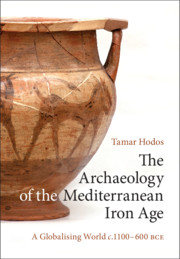Book contents
- The Archaeology of the Mediterranean Iron Age
- The Archaeology of the Mediterranean Iron Age
- Copyright page
- Dedication
- Contents
- Illustrations
- Preface
- Acknowledgements
- One Interpreting the Mediterranean
- Two Chronologies and Histories
- Three The Movement of People
- Four Contacts and Exchanges
- Five Urbanisation
- Six Written Words
- Seven Conclusions
- Notes
- References
- Index
One - Interpreting the Mediterranean
Published online by Cambridge University Press: 12 September 2020
- The Archaeology of the Mediterranean Iron Age
- The Archaeology of the Mediterranean Iron Age
- Copyright page
- Dedication
- Contents
- Illustrations
- Preface
- Acknowledgements
- One Interpreting the Mediterranean
- Two Chronologies and Histories
- Three The Movement of People
- Four Contacts and Exchanges
- Five Urbanisation
- Six Written Words
- Seven Conclusions
- Notes
- References
- Index
Summary
The Mediterranean is both simple and challenging to define. It is an inland sea where the continents of Europe, Asia and Africa meet (Figure 1.1). It is bounded by a coastline that extends from the shores of modern day Syria, Lebanon and Israel in the east to Morocco and Gibraltar in the west, and it is ringed by mountains for much of its perimeter. This is particularly true along its northern edge, where the environment mutates between high, wide mountainous ranges, fertile upland plateaux, and lower-lying plains. Along its southern littoral, there are sharply defined landscapes of fecund hinterlands and desert expanses. The sea itself is often considered an open, uniform expanse between landfalls that is described by its surface conditions, currents and wind patterns. Its islands may be regarded as stepping stones across the expanse of water and, indeed, have been used by people in this way throughout its inhabited history. Collectively, these present a kind of unification to the definition of what the Mediterranean is. But such a singular conceptualisation can break down when one recognises that the Mediterranean comprises the sum of many seas, such as the Aegean, Adriatic and Tyrrhenian, each of which possesses its own character, and as a result requires its own distinctive navigation methods and sailing crafts.
- Type
- Chapter
- Information
- The Archaeology of the Mediterranean Iron AgeA Globalising World c.1100–600 BCE, pp. 1 - 34Publisher: Cambridge University PressPrint publication year: 2020



